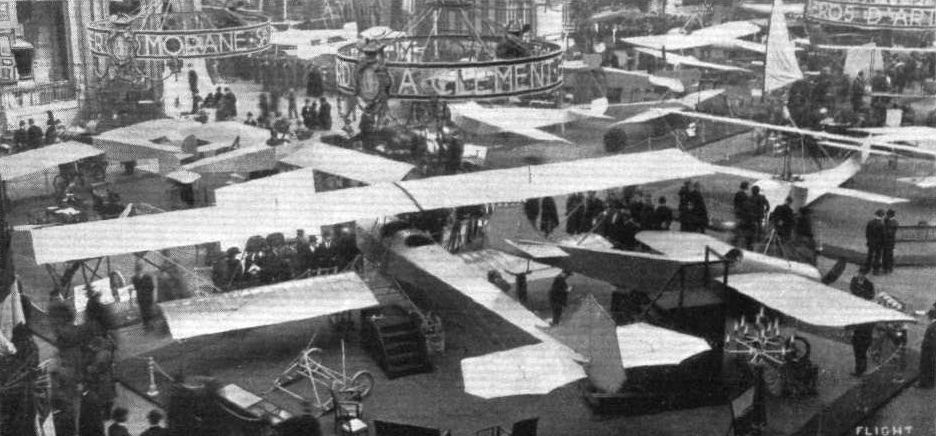L.Opdyke French Aeroplanes Before the Great War (Schiffer)
Deleted by request of (c)Schiffer Publishing
Military Biplane: also a 2-seater:
(Span (upper): 11 m; (lower): 7.8 m; length: 9.8 m; wing area: 28 sqm; weight: 400 kg; speed: 80 kmh; 40/50 hp))
Jane's All The World Aircraft 1913
CLEMENT-BAYARD. Usines Clement-Bayard, 33 quai Michelet, Levallois-Perret (Seine).]
1913. 1913.
Military 3-seater Military single seater
biplane. monoplane.
Length............feet(m) 37 (11.20) 24-2/3 (7.50)
Span, upper.......feet(m) 52 (16) 30 (9.20)
Span, lower.......feet(m) 36 (11) ...
Area...........sq.ft(m?.) 533 (50) 172 (16)
Weight,total...lbs.(kgs.) 2425 (1100) 1146 (520)
Weight,useful..lbs.(kgs.) 1014 (460) 441 (200)
Motor................h.p. 100 Gnome 70 Gnome
Speed, max....m.p.h.(km.) 53 (85) 75 (120)
Speed, min... m.p.h.(km.) ... ... Endurance............hrs. ... ...
Notes.--Control: lateral, warping.
Журнал Flight
Flight, November 9, 1912.
THE PARIS AERO SALON.
Clement-Bayard.
THEIR monoplane is one of the prettiest jobs in the whole Salon. Hardly the same can be said of the biplane they are exhibiting, for, although good throughout as concerns both design and workmanship, it seems considerably more complicated about the chassis than it need be. The monoplane is a single-seater fitted with 50-h.p. Gnome motor, and betrays traces of R.E.P. influence in its design. Its body, for instance, is almost identical with that of the machine we mention; also, at first sight, is the chassis, but on closer examination it will be seen that it works on a different principle. Its two running wheels are mounted on a common axle that is strapped down by rubber springs to a horizontal tubular member, which unites the basis of two "V's" extending downward from the fuselage. One of our sketches shows this point well, and in the same drawing may be seen how the fixed horizontal member and the movable axle are connected as a precaution against an extensive smash occurring should the rubbers break. Altogether, it is the neatest and, we should think, the most efficient chassis this year's Salon has brought forth. On the machine shown the wings are constructed chiefly of wood, but have tubular spars of steel. We were informed, however, that wings with an all-metal skeleton had been made for the monoplane, and, in fact, they would be fitted to the machine before the Show closes. Its tail is a lifting organ, and singularly pretty in outline. It is kept clear of the ground by a neat skid built up of laminations of bent wood.
The large three-seated biplane has a fuselage which only differs from that of the monoplane as regards size. Its tail organs, too, are identical. The main points of difference lie in its landing gear, and in the fact that it has two spreads of wing instead of one. Its chassis is a rather mote complicated version of that which was shown on their biplane last year. It consists of two horizontal wooden skids united to the fuselage by a structure of steel tubing. At the rear extremity of each skid is hinged a steel fork in the form of a triangle, which supports a pair of wheels. The shock absorbers are fitted horizontally between the front of the skid and the base of the fork, so that, should there be a shock on landing, the wheels may give in a vertical direction. Behind the two main skids, and attached to the base of the fuselage, is a third skid with wheels, which, in that position, does away with the necessity of fitting a tail skid. The planes of the biplanes are so designed as regards their attachment to the fuselage that they may be dismantled in a minimum of time. A triangular construction of steel tubing surrounds the body in the neighbourhood of its centre of gravity, and to this structure the planes are assembled. Their cross bracing is rather interesting, and this we illustrate by means of a sketch, for this system does away with a good deal of strutting and wiring, and materially reduces the head resistance of that part of the machine. Inside the body room is provided for two passengers sitting side-by-side in advance of the pilot.
On the stand we had the good fortune to renew our acquaintance with M. Robert Grandseigne, who was a year or so ago connected with the English Bristol Company. He is now engaged in experiments for the Clement-Bayard firm, with a miniature hydro-monoplane, having more or less the characteristics of the little Santos Dumont Demoiselle, which this firm used to construct in days gone by. It is to be quite an inexpensive and popular model, priced somewhere m the neighbourhood of L400, and fitted with the same type of horizontal opposed two-cylinder motor as those with which the Demoiselles were equipped. Already considerable success has been achieved by this model, and now it only remains to standardize the machine. We may expect its official appearance in about two months time, when M. Grandseigne has promised us we may be able to give our readers a complete illustrated description of this interesting machine. Further, he informs us, the Clement-Bayard works have under construction an enormous biplane driven by an engine of 500-h.p. and capable of lifting a minimum load of twelve passengers. As the controls for a machine of this size would be necessarily difficult to operate by manual power alone, power relays driven by compressed air, are being designed to perform this function at the will of the pilot.
It is interesting that whereas last year the greater part of the Clement-Bayard stand was occupied with a nacelle for a dirigible this year there is nothing on the stand that would give one to imagine that the proprietars ever had anything to do with motor balloon construction.





